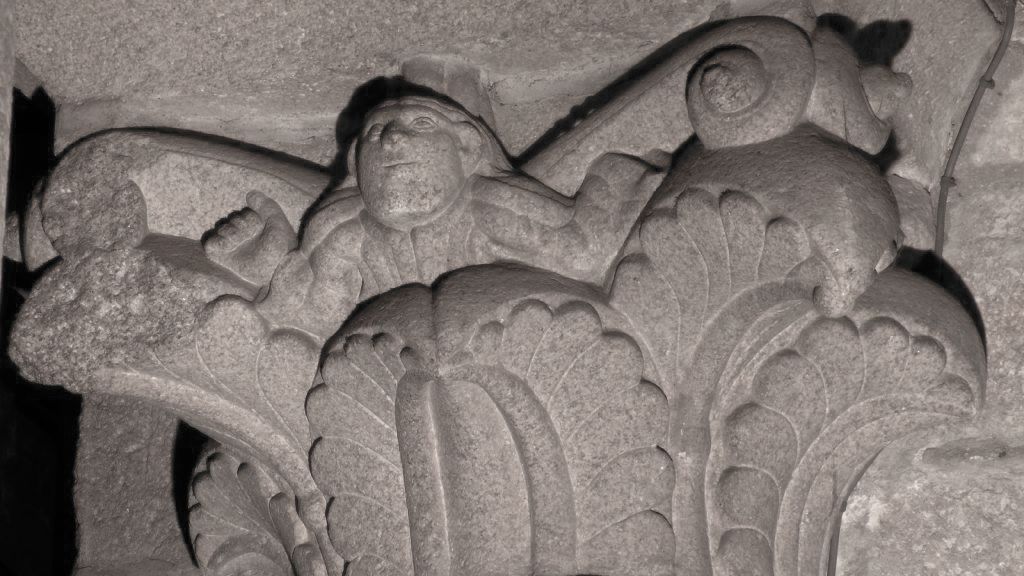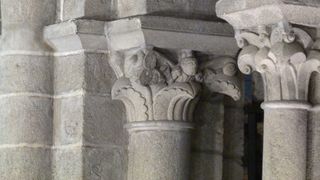Long-hidden 'selfie' of a medieval mason found in historic Spanish cathedral
The craftsman's identity is lost to time, but his self-portrait was set in stone

During the 11th century, an unknown, lowly medieval mason held an important job: helping to build the grand Santiago de Compostela Cathedral in northern Spain, now one of the country's most famous churches. That craftsman's identity has been lost to time, but he left behind a tribute to himself in stone — a cleverly concealed self-portrait.
Whoever this mason was, his sneakily-executed "selfie" went unnoticed for about 900 years, until it was recently spotted by an art historian during a stone-by-stone survey of the cathedral.
In the carving, a jolly-looking round face peers out over fronds of foliage. Measuring about 11 inches (28 centimeters) tall and located at the top of a pillar around 40 feet (12 meters) off the ground, the portrait was positioned so that it would go unnoticed by the cathedral's clergy, but would be easy for fellow masons to find and appreciate, ArtNet reported.
Related: The 25 most mysterious archaeological finds on Earth
Jennifer Alexander, a scholar in the History of Art department at the University of Warwick in the United Kingdom, was leading a team of experts in a painstaking search for mason's marks in the cathedral — one stone at a time — when she found "our little figure," Alexander told Live Science in an email. Her team was paying close attention to the upper parts of the building; on the ground level, many of the stones were covered by paint applied over centuries. But stones that were installed higher up retained their original surface markings, Alexander explained.
"We shone our lights on the upper capitals in the gallery, which is a part of the building the public doesn't access and the clergy rarely used," Alexander said. As they recorded the marks left behind by stonemasons 900 years ago, "suddenly we were face-to-face with one of the men themselves," she said in the email.
Remarkable details in the self-portrait suggested that the carver must have been a talented stoneworker, as the granite stone used in the building is difficult to shape. "And yet his hair is detailed and you can make out all his fingers," Alexander said. "Although these people were trained in the craft tradition, they were very much the artists of their period, quite capable of creating sculpture as well as cutting stone."
Sign up for the Live Science daily newsletter now
Get the world’s most fascinating discoveries delivered straight to your inbox.

Artisan self-portraits such as these frequently appear in medieval buildings. They are easily concealed "in plain sight" amid other sculptural flourishes and portraiture, though often "they're hidden away where only another mason, or someone working on the building would find them," such as the portrait in Santiago de Compostela, according to Alexander.
Another memorable stonemason selfie lurks in Southwell Minster, a church in Nottinghamshire, England, "where he's grinning at you at the bottom of the staircase to the chapter house roof," Alexander said. "But he's in the dark, so you have to be carrying a light to spot him."
But even with all the portrait details in the cathedral selfie, the carver's name will likely never be known, as historic records of low-ranking builders — even on important construction projects — are exceptionally rare, Alexander said.
"Finding the identity of one mason who carved his own image would be very special — and I've never managed to do this!" she said.
Originally published on Live Science.

Mindy Weisberger is an editor at Scholastic and a former Live Science channel editor and senior writer. She has reported on general science, covering climate change, paleontology, biology and space. Mindy studied film at Columbia University; prior to Live Science she produced, wrote and directed media for the American Museum of Natural History in New York City. Her videos about dinosaurs, astrophysics, biodiversity and evolution appear in museums and science centers worldwide, earning awards such as the CINE Golden Eagle and the Communicator Award of Excellence. Her writing has also appeared in Scientific American, The Washington Post and How It Works Magazine. Her book "Rise of the Zombie Bugs: The Surprising Science of Parasitic Mind Control" will be published in spring 2025 by Johns Hopkins University Press.











